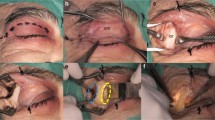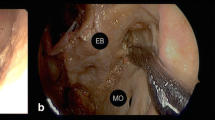Abstract
Purpose
The endoscopic endonasal approach (EEA) is a minimally invasive and promising modality for treating traumatic superior orbital fissure (SOF) syndrome (tSOFS). Recently, the endoscopic transorbital approach (ETOA) has been considered an alternative method for reaching the anterolateral skull base. This study accessed the practicality of using the ETOA to treat SOF decompression using both cadaveric dissection and clinical application.
Methods
Bilateral anatomic dissections were performed on four adult cadaveric heads using the ETOA and EEA to address SOF decompression. The ETOA procedure for SOF decompression is described, and the extent of SOF decompression was compared between the ETOA and EEA. The clinical feasibility of the ETOA for treating SOF decompression was performed in two patients diagnosed with tSOFS.
Results
ETOA allowed for decompression over the lateral aspect of the SOF, from the meningo-orbital band superolaterally to the maxillary strut inferomedially. By contrast, the EEA allowed for decompression over the medial aspect of the SOF, from the lateral opticocarotid recess superiorly to the maxillary strut inferiorly. In both patients treated using the ETOA and SOF decompression, the severity of ophthalmoplegia got obvious improvement.
Conclusions
Based on the cadaveric findings, ETOA provided a feasible access pathway for SOF decompression with reliable outcomes, and our patients confirmed the clinical efficacy of the ETOA for managing tSOFS.






Similar content being viewed by others
References
Chen CT, Chen YR (2010) Traumatic superior orbital fissure syndrome: current management. Craniomaxillofac Trauma Reconstr 3:9–16. https://doi.org/10.1055/s-0030-1249369
Chen CT, Wang TY, Tsay PK, Huang F, Lai JP, Chen YR (2010) Traumatic superior orbital fissure syndrome: assessment of cranial nerve recovery in 33 cases. Plast Reconstr Surg 126:205–212. https://doi.org/10.1097/prs.0b013e3181dab658
Jin H, Gong S, Han K et al (2018) Clinical management of traumatic superior orbital fissure and orbital apex syndromes. Clin Neurol Neurosurg 165:50–54. https://doi.org/10.1016/j.clineuro.2017.12.022
Jin H, Wang S, Hou L et al (2010) Clinical treatment of traumatic brain injury complicated by cranial nerve injury. Injury 41:918–923. https://doi.org/10.1016/j.injury.2010.03.007
Dallan I, Castelnuovo P, de Notaris M et al (2013) Endoscopic endonasal anatomy of superior orbital fissure and orbital apex regions: critical considerations for clinical applications. Eur Arch Otorhinolaryngol 270:1643–1649. https://doi.org/10.1007/s00405-012-2281-3
Liu J, Zhao J, Wang Y et al (2021) Simultaneous endoscopic endonasal decompression of the optic canal, superior orbital fissure, and proper orbital apex for traumatic orbital apex syndrome: surgical anatomy and technical note. Front Surg 8:811706. https://doi.org/10.3389/fsurg.2021.811706
Zhou G, Yu B, Tu Y, Shi J, Wu W (2020) Endoscopic transethmosphenoid optic canal and orbital apex decompression for patients with traumatic orbital apex syndrome. J Craniofac Surg 31:214–218. https://doi.org/10.1097/scs.0000000000005904
Di Somma A, Andaluz N, Cavallo LM et al (2018) Endoscopic transorbital superior eyelid approach: anatomical study from a neurosurgical perspective. J Neurosurg 129:1203–1216. https://doi.org/10.3171/2017.4.jns162749
Kong DS, Kim YH, Hong CK (2020) Optimal indications and limitations of endoscopic transorbital superior eyelid surgery for spheno-orbital meningiomas. J Neurosurg 134:1472–1479. https://doi.org/10.3171/2020.3.jns20297
Vural A, Carobbio ALC, Ferrari M et al (2021) Transorbital endoscopic approaches to the skull base: a systematic literature review and anatomical description. Neurosurg Rev 44:2857–2878. https://doi.org/10.1007/s10143-020-01470-5
Yoo J, Park HH, Yun IS, Hong CK (2021) Clinical applications of the endoscopic transorbital approach for various lesions. Acta Neurochir 163:2269–2277. https://doi.org/10.1007/s00701-020-04694-y
Jeon C, Hong SD, Woo KI et al (2020) Use of endoscopic transorbital and endonasal approaches for 360 degrees circumferential access to orbital tumors. J Neurosurg. https://doi.org/10.3171/2020.6.jns20890. (Epub ahead of print)
Kong DS, Young SM, Hong CK et al (2018) Clinical and ophthalmological outcome of endoscopic transorbital surgery for cranioorbital tumors. J Neurosurg 131:667–675. https://doi.org/10.3171/2018.3.jns173233
Corrivetti F, de Notaris M, Di Somma A et al (2022) “Sagittal crest”: definition, stepwise dissection, and clinical implications from a transorbital perspective. Oper Neurosurg (Hagerstown) 22(5):e206–e212. https://doi.org/10.1227/ons.0000000000000131
Acartürk S, Seküçoğlu T, Kesiktäs E (2004) Mega dose corticosteroid treatment for traumatic superior orbital fissure and orbital apex syndromes. Ann Plast Surg 53:60–64. https://doi.org/10.1097/01.sap.0000106424.54415.dc
Rohrich RJ, Hackney FL, Parikh RS (1995) Superior orbital fissure syndrome: current management concepts. J Craniomaxillofac Trauma 1:44–48
Ammirati M, Bernardo A (2007) Anatomical study of the superior orbital fissure as seen during a pterional approach. J Neurosurg 106:151–156. https://doi.org/10.3171/jns.2007.106.1.151
Feiz-Erfan I, Spetzler RF, Horn EM et al (2008) Proposed classification for the transbasal approach and its modifications. Skull Base 18:29–47. https://doi.org/10.1055/s-2007-994292
López CB, Di Somma A, Cepeda S (2021) Extradural anterior clinoidectomy through endoscopic transorbital approach: laboratory investigation for surgical perspective. Acta Neurochir 163:2177–2188. https://doi.org/10.1007/s00701-021-04896-y
Foulsham W, North VS, Botsford BW et al (2022) Multilayered macular hemorrhages as an unusual complication of transorbital neuroendoscopic surgery. Am J Ophthalmol Case Rep 26:101556. https://doi.org/10.1016/j.ajoc.2022.101556
Kim W, Moon JH, Kim EH, Hong CK, Han J, Hong JB (2021) Optimization of orbital retraction during endoscopic transorbital approach via quantitative measurement of the intraocular pressure - [SevEN 006]. BMC Ophthalmol 21:76. https://doi.org/10.1186/s12886-021-01834-5
Noiphithak R, Yanez-Siller JC, Revuelta Barbero JM, Otto BA, Carrau RL, Prevedello DM (2019) Comparative analysis between lateral orbital rim preservation and osteotomy for transorbital endoscopic approaches to the cavernous sinus: an anatomic study. Oper Neurosurg (Hagerstown) 16:86–93. https://doi.org/10.1093/ons/opy054
Lim J, Sung KS, Kim W et al (2021) Extended endoscopic transorbital approach with superior-lateral orbital rim osteotomy: cadaveric feasibility study and clinical implications (SevEN-007). J Neurosurg. https://doi.org/10.3171/2021.7.jns2199624. (Epub ahead of print)
Dallan I, Castelnuovo P, Locatelli D et al (2015) Multiportal combined transorbital transnasal endoscopic approach for the management of selected skull base lesions: preliminary experience. World Neursurg 84:97–177. https://doi.org/10.1016/j.wneu.2015.02.034
Dallan I, Di Somma A, Prats-Galino A et al (2017) Endoscopic transorbital route to the cavernous sinus through the meningo-orbital band: a descriptive anatomical study. J Neurosurg 127:622–629. https://doi.org/10.3171/2016.8.JNS16465
Jung IH, Yoo J, Choi S et al (2022) Endoscopic transorbital approach to the cavernous sinus: cadaveric anatomy study and clinical application (SevEN-009). Front Oncol 12:962598. https://doi.org/10.3389/fonc.2022.962598
Funding
This work was supported by the Tri-Service General Hospital of Taiwan’s Medical Research Project (TSGH-D-110074 and TSGH-D-111088).
Author information
Authors and Affiliations
Corresponding author
Ethics declarations
Conflict of interest
The authors declare that they have no conflict of interest.
Ethical approval
All procedures performed in studies involving human participants were in accordance with the ethical standards of the institutional and/or national research committee and with the 1964 Helsinki declaration and its later amendments or comparable ethical standards.
Informed consent
Informed consent was obtained from all individual participants included in the study.
Additional information
Publisher's Note
Springer Nature remains neutral with regard to jurisdictional claims in published maps and institutional affiliations.
Rights and permissions
Springer Nature or its licensor (e.g. a society or other partner) holds exclusive rights to this article under a publishing agreement with the author(s) or other rightsholder(s); author self-archiving of the accepted manuscript version of this article is solely governed by the terms of such publishing agreement and applicable law.
About this article
Cite this article
Lin, BJ., Ju, DT., Hueng, DY. et al. Endoscopic transorbital decompression for traumatic superior orbital fissure syndrome: from cadaveric study to clinical application. Eur Arch Otorhinolaryngol 281, 1933–1940 (2024). https://doi.org/10.1007/s00405-023-08440-9
Received:
Accepted:
Published:
Issue Date:
DOI: https://doi.org/10.1007/s00405-023-08440-9




